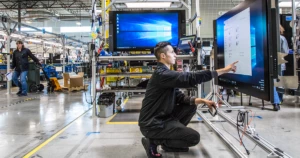
Leveraging the Microsoft Feedback Loop in the banking industry

The Microsoft Digital Feedback Loop is about understanding how your captured data better serves your customers and removes analytical silos. In banking, the feedback loop can help you integrate data across your branch, including product offerings, customers, internal operations, and employees.
Why the Microsoft Digital Feedback Loop?
The current widespread business disruption is driven by technology. It’s important to note that this disruption is not evenly distributed across all industries. Those industries that have been more severely affected include transportation and automotive, home goods, media, and hospitality. More specifically, these industries have been impacted by products like Uber, iRobot, ecobee, Netflix, and Airbnb.
These products and companies are representative of ‘digital natives’ that have leveraged their software expertise to create a natural advantage over established players. Digital natives typically have three times the number of developers than established players. This comparative advantage allows for quicker updates for both apps and customer-facing products based on customer feedback. This, in turn, provides an opportunity for companies to achieve higher customer ratings.
The net effect of faster releases is higher revenue growth:
| Releases | |
| >10% faster | 2.5x growth |
| >25% faster | 4.0x growth |
| Continuous delivery | 9.0x growth |
Companies practicing continuous delivery are realizing a 20% lift in revenues over time.
What is the Microsoft Digital Feedback Loop?
Perhaps it’ll be helpful to look closer at an example in a specific industry, such as the automotive industry. A car manufacturer collects near-real-time information on its vehicles and analyzes ‘signals’ using AI to determine which ‘actions’ require a response. The car manufacturer also reviews social media activity on its vehicles to track customer complaints and comments.
Customers complained that the autopilot was taking curves faster than other vehicles. By viewing the telemetry from the car, the manufacturer can both confirm and review activity based on the ‘signals’ from the car itself. It can also see that customers are hitting the brakes on curves. Once equipped with this data, the manufacturer can then react and remotely update the autopilot so it takes curves slower.
Some car manufacturers can repair 90% of customer issues remotely. These repairs happen even when the vehicle is sitting in the customer’s driveway. Post repair, the car manufacturer can close the feedback loop by posting to social media that it responded to customer concerns and needs both quickly and efficiently.
Manufacturers can also review both operations and employee performance with the Microsoft Digital Feedback Loop. Electric car manufacturers can collect data on where customers charge their cars during road trips. More specifically, these manufacturers are using this data to have the GPS navigation system plan road trips through charging locations, placing a priority on those stations that can charge vehicles quickly. This might also entice small businesses to include charging locations on-site along commonly traveled routes to attract more business traffic. With charging stations being more accessible, more electric car drivers would stop along a travel route at a small business location and spend 30 minutes shopping and browsing while waiting for their vehicle to fully charge.
In a recent IDS study, approximately 70% of organizations claim they have digital strategy capability. However, just 30% of them acknowledged that they have a company-wide data sharing strategy. This disconnect has a profound effect on the ability to intelligently use data across four major digital transformation goals:
- Engage customers
- Optimize operations
- Empower people
- Transform products
How can bank branches leverage the Digital Feedback Loop?
In my last blog post, we talked about branch digital twins. A digital twin collects all signals from employees, customers, operations, and bank products into a single repository. Within this repository, AI is used to gain insights and take action.
You might wonder what signals are being collected. Here are some examples:
- From products, we can view usage trends from both online and card-present transactions.
- From customers, we can view location information. This, however, would only be available if customers opt-in. If the customer is in a branch location, we can deliver targeted advertisements based on card purchases, such as mortgage rate approvals or certain banking products that match a customer’s purchasing pattern or any changes to their family life.
Let’s now focus on employees and operations. For operational transformation, let’s think about how branch operations both adapt and adjust with new information from signals across all products, customers, operations, and employees. This data indicates both when and where customers are visiting a branch, even if they do not perform a banking transaction. For example, a small business owner might visit a branch three times a week, but only perform transactions at the teller twice a week. The third visit is reserved for internal communications and dealings between the small business owner and branch employees.
What is that branch doing that should be replicated in others to attract small business owners to visit consistently and more often?
How can bank branches transform their business models with the Microsoft Feedback Loop?
Mixing in alternative data, such as weather or local COVID-19 rates, suggests how customers are using branches. This data can be used to develop staffing plans, improve the customer experience, and create a socially distanced layout within physical branch locations. Given all these ‘signals’ both in and around the branch, the Microsoft Digital Feedback Loop provides information on customers, products, operations, and employees. And, by leveraging AI, these insights can be automated to improve the overall customer experience.
Here are some actions that a branch can take to leverage the Microsoft Data Feedback Loop:
- Review how you explore your bank’s data across transactions, customer profiles, customer service interactions, and branch data. Have a veneer across these data sources to allow AI insights by leveraging PowerBI and AI Builder.
- Update your mobile banking app to provide more telemetry on customer use.
- Leverage AI technology, such as Azure AutoML and Cognitive Services, to automate operational processes such as staffing levels, target in-branch advertisements to attract customer interest, and find a connection between small business banking customers and retail customers.




